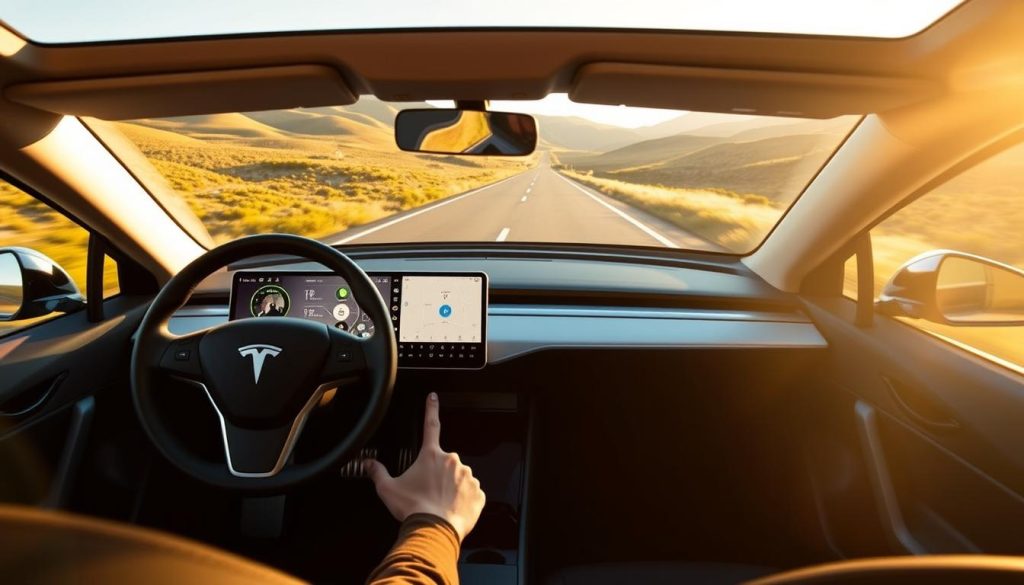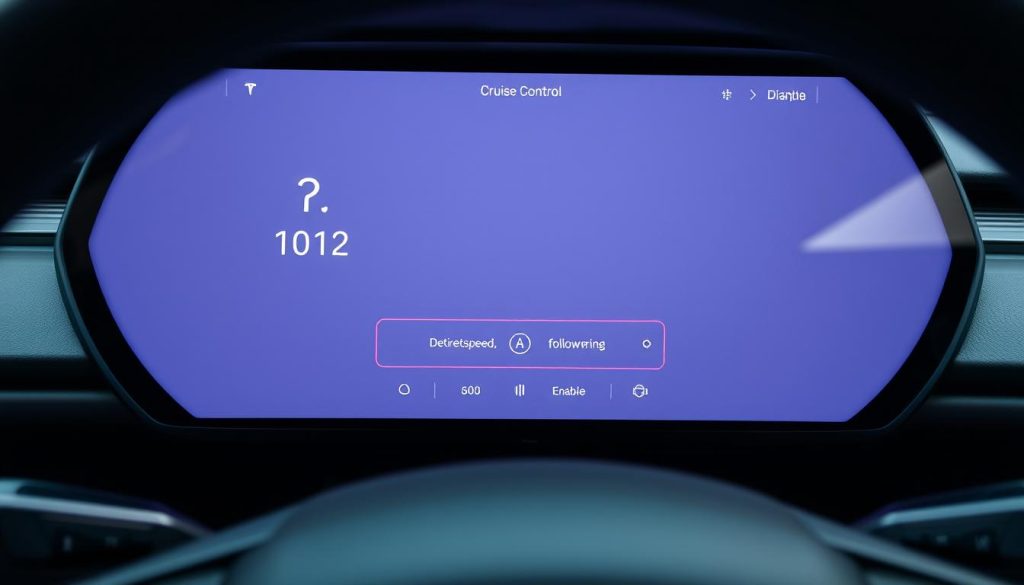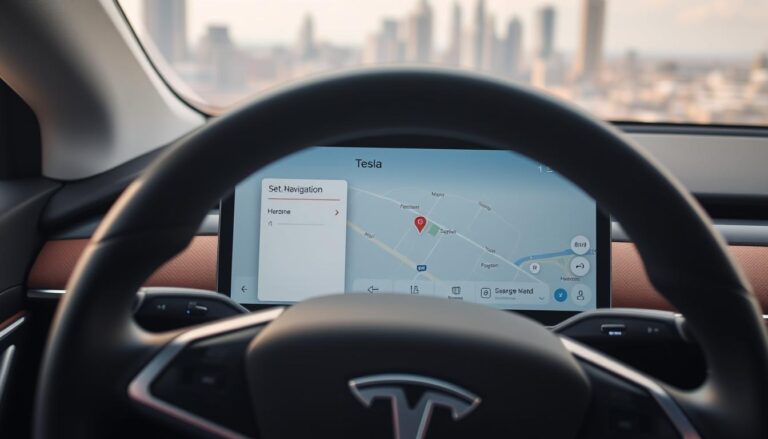The Tesla Model Y epitomizes the pinnacle of automotive innovation, boasting a suite of cutting-edge features that redefine the driving experience. At its core lies the Autopilot system, a testament to technological prowess, which encompasses a state-of-the-art cruise control mechanism.
This advanced feature empowers drivers to embark on extended voyages with unparalleled comfort, ensuring a consistent and secure distance from preceding vehicles. By honing your proficiency in the Tesla Model Y‘s cruise control functionalities, you can significantly elevate your driving experience, diminish driver fatigue, and bolster overall road safety.
Key Takeaways
- Understand the benefits of using cruise control on Tesla Model Y
- Learn how to effectively use Autopilot features for effortless driving
- Discover tips for maximizing the safety and convenience of cruise control
- Enhance your driving experience with advanced driving features
- Improve road safety by maintaining a safe distance from other vehicles
Understanding Cruise Control on Tesla Model Y
The Tesla Model Y’s cruise control system is a cornerstone of its driving experience, offering a blend of basic and advanced functionalities. This sophisticated system is engineered to enhance both comfort and efficiency during your journeys.
Basic vs. Advanced Cruise Control Features
The Tesla Model Y’s cruise control system is divided into two tiers: basic and advanced. The basic system allows drivers to set a constant speed, whereas the advanced Autopilot features introduce more complex functionalities.
Standard Cruise Control Capabilities
The standard cruise control on the Tesla Model Y enables drivers to establish a desired speed, which the vehicle maintains unless the driver intervenes. This capability is invaluable for extended highway drives.
Autopilot and Full Self-Driving Features
Autopilot and Full Self-Driving (FSD) capabilities represent the pinnacle of Tesla’s cruise control offerings. Autopilot enhances safety and convenience by automatically adjusting speed, steering, and braking in specific conditions.
Benefits of Using Cruise Control
Utilizing cruise control on your Tesla Model Y yields several advantages, including diminished driver fatigue and enhanced energy efficiency.
Reduced Driver Fatigue
Cruise control minimizes the need for constant speed adjustments, thus reducing driver fatigue, a significant benefit during prolonged drives.
Improved Energy Efficiency
Maintaining a consistent speed through cruise control optimizes energy consumption, a critical advantage for electric vehicles such as the Tesla Model Y.
| Feature | Description | Benefit |
|---|---|---|
| Standard Cruise Control | Maintains a set speed | Reduces driver fatigue |
| Autopilot | Automatically adjusts speed and steering | Enhances safety and convenience |
| Full Self-Driving (FSD) | Advanced Autopilot features for semi-autonomous driving | Future-proofs your driving experience |

How to Use Cruise Control on Tesla Model Y
Mastering the operation of cruise control on your Tesla Model Y is crucial for optimizing its advanced functionalities. This feature enables the vehicle to maintain a consistent speed on highways, enhancing the driving experience by reducing fatigue and increasing comfort during extended journeys.
Activating Basic Cruise Control
The initiation of cruise control on your Tesla Model Y is a straightforward procedure. It necessitates driving at a velocity exceeding 18 mph, a fundamental requirement for the activation of this feature.
Using the Right Steering Wheel Stalk
To initiate cruise control, pull the stalk towards you once. This action will activate the cruise control system, and a confirmation will be displayed on your dashboard.
Confirming Activation via Dashboard
Upon successful activation, the cruise control indicator will be displayed on your dashboard, indicating that the system is operational and set to maintain your current speed.
Setting and Adjusting Your Speed
Once cruise control is activated, you can modify your speed as necessary. The Tesla Model Y offers precise control over speed adjustments.
Speed Adjustment Methods
Speed adjustments can be made using the steering wheel controls. The “+” button increases your speed, while the “-” button decreases it.
Using Speed Increments
The Tesla Model Y permits speed adjustments in 1 mph increments (or 1 km/h for metric users). This level of precision allows for the customization of speed to meet specific driving conditions or requirements.
Deactivating Cruise Control
Disengaging cruise control is a simple process, accessible through manual intervention or automatic disengagement under specific conditions.
Manual Deactivation Methods
Manual disengagement of cruise control can be achieved by pressing the brake pedal or by pulling the stalk towards you again. Both methods effectively deactivate the cruise control system.
Automatic Disengagement Scenarios
Cruise control will automatically disengage in certain scenarios, such as when the vehicle comes to a complete stop or when the Autopilot system detects a need to take control.

Mastering Autopilot and Traffic-Aware Cruise Control
Attaining proficiency in Autopilot and Traffic-Aware Cruise Control within your Tesla Model Y can profoundly elevate your driving experience. These cutting-edge functionalities are engineered to augment both safety and convenience, thus rendering extended journeys more manageable and less taxing.
Enabling Traffic-Aware Cruise Control
To activate Traffic-Aware Cruise Control, it is imperative that your Tesla is outfitted with Autopilot or Full Self-Driving Capability (FSD). The activation procedure is straightforward:
Activation Requirements
- Verify that Autopilot is activated in your Tesla’s settings.
- Attain a velocity of at least 18 mph (29 km/h) on highways or freeways.
Confirmation Indicators
Upon activation, the instrument panel will exhibit a confirmation indicator, affirming that Traffic-Aware Cruise Control is operational.
Understanding the Display Interface
The display interface furnishes essential information regarding the status of Autopilot and Traffic-Aware Cruise Control. Mastery of this interface is fundamental for the effective utilization of these functionalities.
Reading the Visualization Screen
The visualization screen on your Tesla’s display delineates the road ahead, detected vehicles, and other pertinent data.
Interpreting Status Icons
Status icons signify whether Autopilot and Traffic-Aware Cruise Control are operational, and if any issues or limitations are detected.
Adjusting Following Distance
Modifying the following distance is paramount for safe navigation. Tesla empowers you to tailor this setting according to your personal preference.
Using the Scroll Wheel
The following distance can be adjusted via the scroll wheel on the steering stalk. This facilitates rapid adjustments during transit.
Recommended Settings for Different Traffic Conditions
| Traffic Condition | Recommended Following Distance |
|---|---|
| Heavy Traffic | Medium to Long |
| Moderate Traffic | Medium |
| Light Traffic | Short to Medium |
For additional insights on mastering your Tesla, consult Tesery’s Tesla Tips.
Advanced Cruise Control Features
The Tesla Model Y’s advanced cruise control system is equipped with features that make highway driving more enjoyable and less stressful. These features are designed to work together seamlessly, providing a more comfortable and safe driving experience.
Navigate on Autopilot Functionality
Navigate on Autopilot is a sophisticated feature that guides the Tesla Model Y through highway on-ramps and off-ramps, adjusting speed according to traffic conditions. This feature is notably beneficial for long road trips.
Highway On-Ramp to Off-Ramp Navigation
The Navigate on Autopilot feature allows for smooth transitions from highway on-ramps to off-ramps, automatically adjusting the vehicle’s speed and lane positioning.
Automatic Lane Changes for Route Following
This feature enables the vehicle to make automatic lane changes to follow the set route, ensuring that the driver stays on course without manual intervention.
Auto Lane Change Features
The Auto Lane Change feature in the Tesla Model Y allows drivers to change lanes with ease, using the turn signal stalk to initiate the maneuver. This feature enhances safety and convenience.
Initiating Lane Changes with Turn Signals
By using the turn signal stalk, drivers can initiate lane changes smoothly and safely, with the system checking for safe conditions before making the change.
Customizing Lane Change Confirmation Settings
Drivers can customize the lane change confirmation settings to suit their preferences, choosing between different levels of confirmation feedback.
Speed Limit Recognition and Adjustment
The Tesla Model Y is equipped with a Speed Limit Recognition feature that uses camera-based detection to identify speed limits and adjust the vehicle’s speed.
Camera-Based Speed Limit Detection
The vehicle’s cameras work in conjunction with the Autopilot system to detect speed limit signs and adjust the cruise control speed to match the limit.
Setting Speed Limit Offset Preferences
Drivers can set their preferred speed limit offset, allowing them to drive slightly above or below the detected speed limit if desired.
Troubleshooting Common Cruise Control Issues
Despite Tesla’s advanced cruise control system, malfunctions can occur. Understanding how to address these problems is crucial. Issues with your Tesla Model Y’s cruise control may arise from camera obstructions, software malfunctions, or sensor malfunctions.
When Cruise Control Won’t Engage
Several potential causes exist when cruise control fails to engage.
Camera Obstruction Problems
Verify that the cameras are unobstructed by dirt, snow, or debris. A thorough cleaning can often rectify the problem.
Software-Related Issues
Software updates can sometimes introduce problems. Ensure your Tesla Model Y is updated to the latest software version.
Handling Unexpected Disengagements
Unexpected disengagements can stem from various factors, including warning alerts or system malfunctions.
Understanding Warning Alerts
Heed warning messages on your dashboard, as they offer vital information about disengagement causes.
Safe Recovery Procedures
In the event of disengagement, regain control of the vehicle safely before attempting to re-engage cruise control.
Camera and Sensor Maintenance
Regular maintenance is essential for the proper functioning of your cruise control.
Cleaning Recommendations
- Clean cameras and sensors regularly with appropriate materials.
- Avoid using harsh chemicals that could damage the equipment.
When to Schedule Service
If issues persist after troubleshooting, it may be necessary to schedule a service appointment with Tesla.
By adhering to these troubleshooting tips and maintaining your Tesla Model Y’s cameras and sensors, you can minimize cruise control issues. This will enhance your driving experience.
Safety Tips and Best Practices
The utilization of Tesla’s cruise control necessitates a dual approach: comprehension of the technology and adherence to established best practices. This feature, while enhancing the driving experience, mandates a heightened state of vigilance and awareness regarding safety protocols.
Maintaining Driver Attention
Driver vigilance is paramount when employing cruise control. Tesla’s Autopilot necessitates driver engagement and preparedness to assume control at any juncture.
Hands-on-Wheel Requirements
It is imperative to maintain hand contact with the steering wheel. The system is programmed to detect and alert the driver if hands are absent from the wheel for an extended duration.
Responding to Attention Alerts
Upon receipt of an attention alert, it is imperative to respond expeditiously. This entails placing hands on the wheel and continuing to monitor the road’s conditions.
Weather and Road Condition Considerations
The impact of weather and road conditions on the safe operation of cruise control cannot be overstated. An understanding of these variables is crucial for the effective utilization of the feature.
Limitations in Poor Weather
In adverse weather conditions such as heavy rain, snow, or fog, the efficacy of cruise control may be diminished. It is prudent to be prepared to assume manual control when circumstances demand it.
Construction Zone Navigation
Navigating through construction zones necessitates heightened awareness. Lane markings may be obscured or altered. Adjust speed appropriately and remain prepared to disengage cruise control.
Legal Requirements and Limitations
Conversely, it is imperative to be cognizant of the legal stipulations and limitations governing the deployment of cruise control.
State-by-State Regulations
Regulatory frameworks regarding the utilization of advanced driver-assistance systems (ADAS) like Autopilot exhibit variability across states. It is advisable to familiarize oneself with the specific legislative mandates within one’s jurisdiction.
Liability Considerations
Grasping the liability implications of cruise control usage is of paramount importance. While Tesla furnishes guidelines, it is incumbent upon drivers to remain attentive and comply with traffic regulations to mitigate potential liabilities.
Conclusion
Attaining proficiency in the cruise control functionalities of your Tesla Model Y can profoundly elevate your driving experience. Grasping and employing the diverse cruise control options enables a more serene and effortless journey, notably on extended road excursions or routine commutes.
The Tesla Model Y’s cruise control system, encompassing its sophisticated Autopilot and Traffic-Aware Cruise Control functionalities, is crafted to deliver a secure and convenient driving ambiance. Adhering to the recommendations and directives presented within this discourse, you can refine your utilization of these functionalities, thus enhancing your driving experience.
To maximize the benefits of your Tesla Model Y’s cruise control functionalities, engage in regular practice with the various features and settings. Acquaint yourself with the display interface and tailor the following distance to your liking. Such actions will empower you to fully leverage the Tesla Model Y’s cruise control features, rendering your drives more pleasurable and devoid of stress.
FAQ
How do I activate cruise control on my Tesla Model Y?
To activate cruise control on your Tesla Model Y, manipulate the right steering wheel stalk. Confirmation of activation is then displayed on the dashboard.
What is the difference between basic and advanced cruise control features on Tesla Model Y?
Basic cruise control features facilitate standard speed control. In contrast, advanced features such as Autopilot and Full Self-Driving Capability offer enhanced functionality. This includes traffic-aware cruise control and automatic lane changes.
How do I adjust my speed while using cruise control on Tesla Model Y?
Adjusting your speed while using cruise control is facilitated by the scroll wheel on the steering wheel. This allows for incremental speed adjustments.
What should I do if my cruise control won’t engage on Tesla Model Y?
Should your cruise control fail to engage, inspect for camera obstructions or software malfunctions. Consult your owner’s manual for troubleshooting guidance or schedule a service appointment if necessary.
How do I maintain driver attention while using cruise control on Tesla Model Y?
Ensure driver attention by maintaining hand contact with the wheel. Be prepared to respond to attention alerts, ensuring readiness to assume vehicle control.
Are there any limitations to using cruise control in poor weather conditions on Tesla Model Y?
Yes, cruise control may face limitations in adverse weather conditions, such as heavy rain or snow. Understanding these limitations is crucial for safe driving.
Can I customize lane change confirmation settings on Tesla Model Y?
Customization of lane change confirmation settings is possible, allowing for a tailored driving experience.
How does Tesla Model Y’s Speed Limit Recognition feature work?
The Speed Limit Recognition feature employs camera-based detection to identify speed limits. It allows for setting a speed limit offset preference, aiding in adherence to speed limits.
What are the legal requirements for using cruise control on Tesla Model Y?
It is imperative to familiarize yourself with state-specific regulations regarding cruise control and Autopilot usage. Understanding liability considerations ensures responsible vehicle operation.
How do I handle unexpected disengagements of cruise control on Tesla Model Y?
Understanding warning alerts is crucial. Follow safe recovery procedures to regain control of the vehicle, ensuring personal and public safety.


